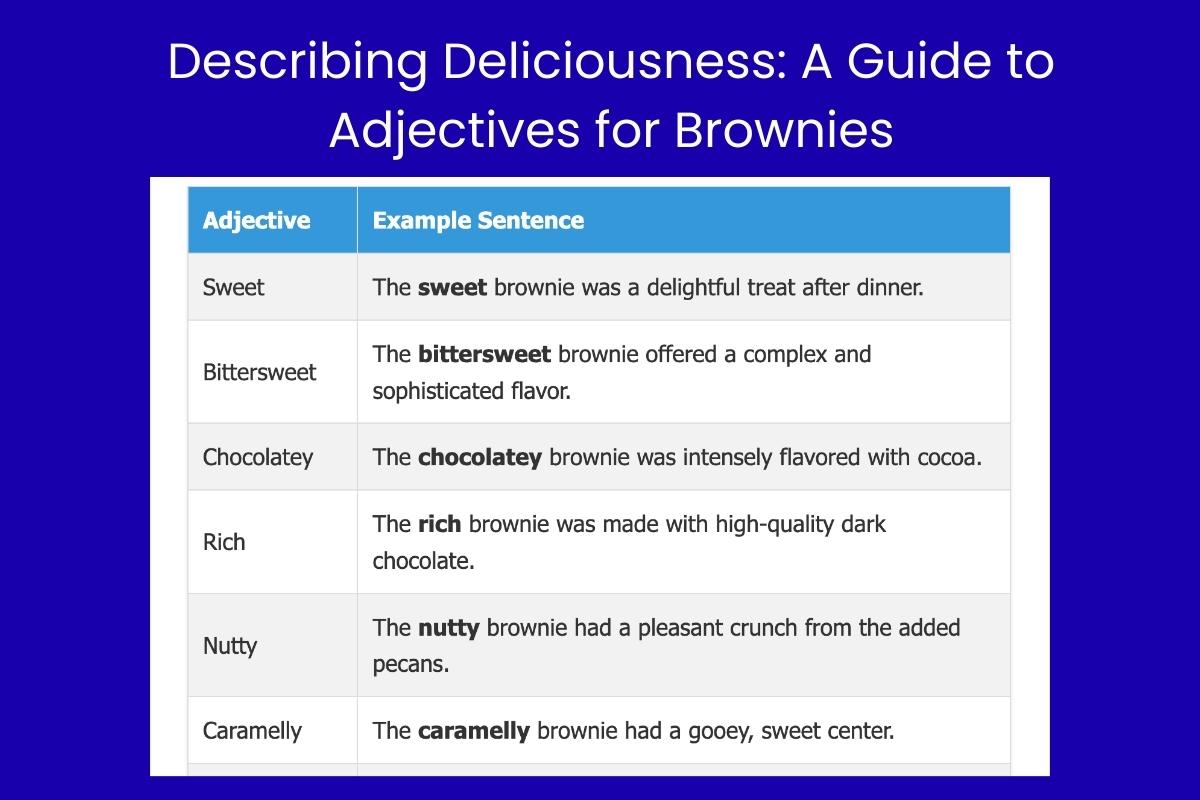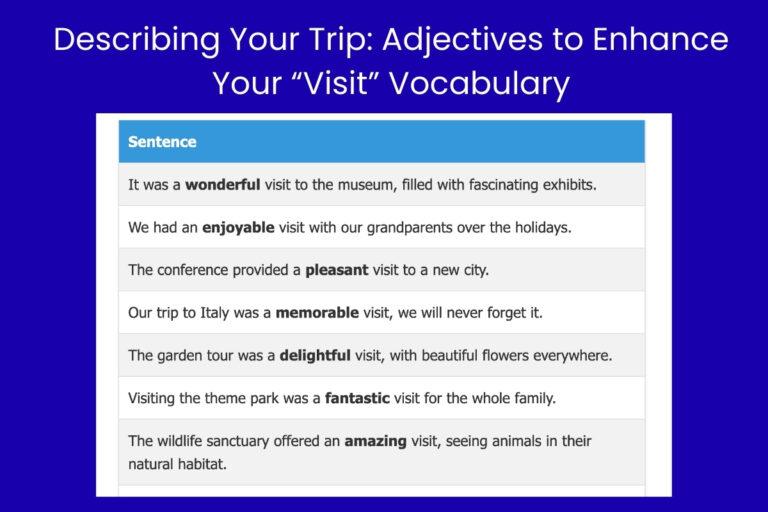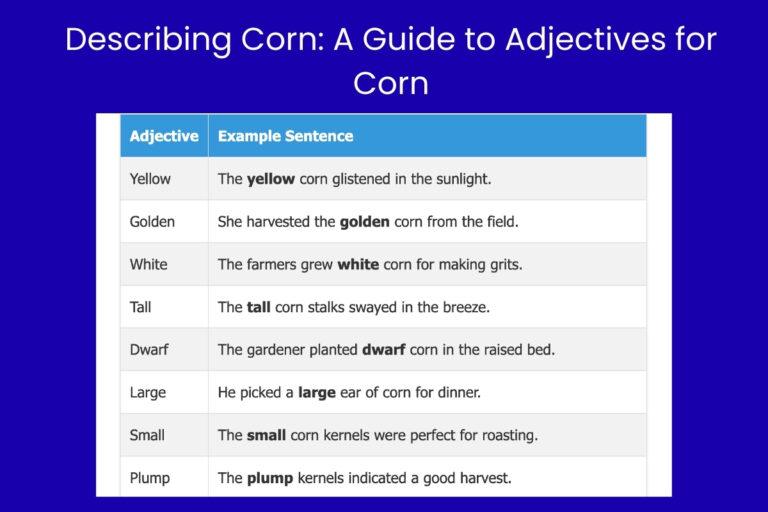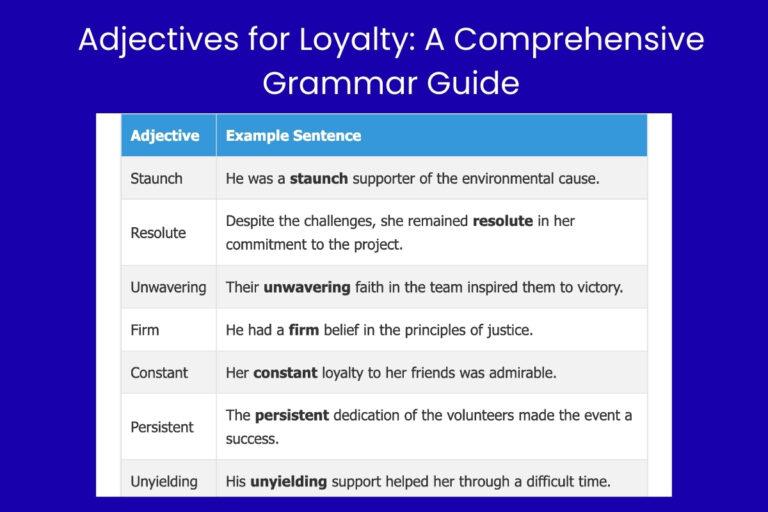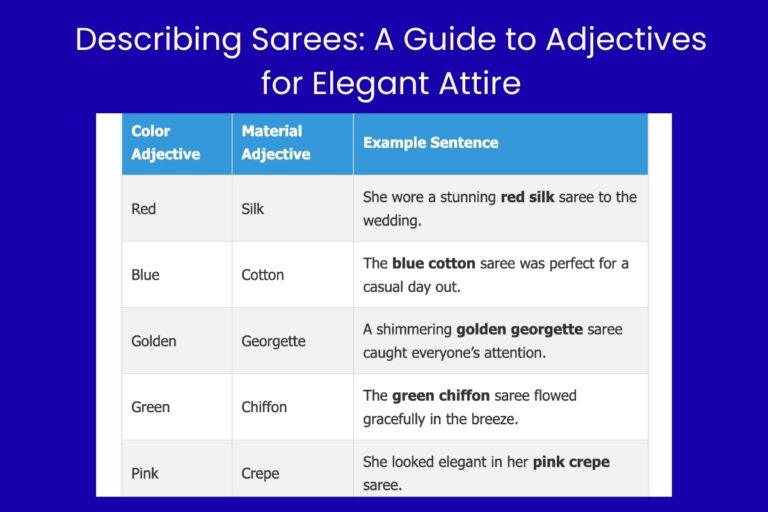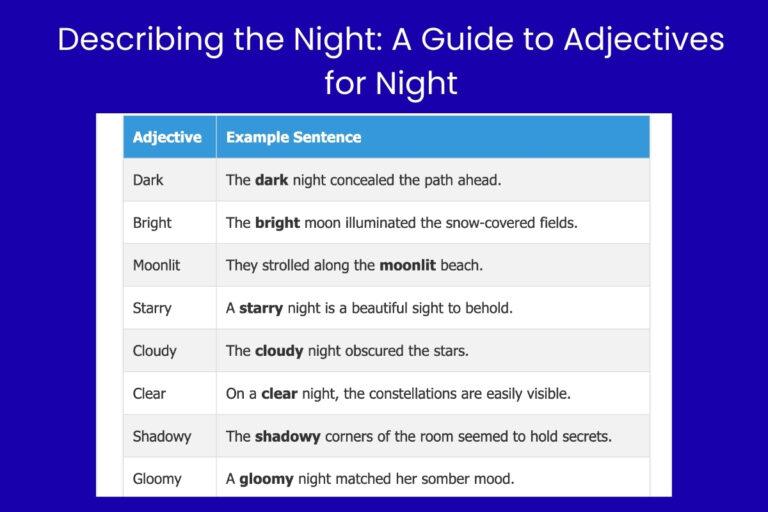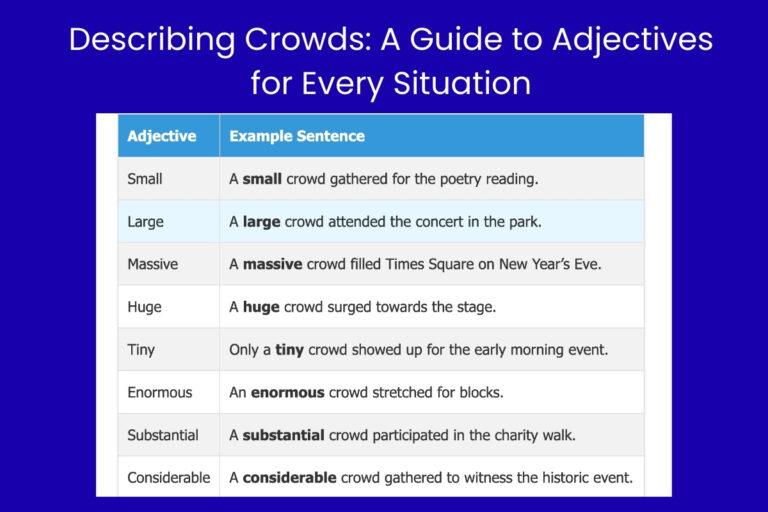Describing Deliciousness: A Guide to Adjectives for Brownies
Brownies, those delightful squares of chocolatey goodness, are a universal treat. But how do you describe their nuanced flavors and textures effectively? Mastering the art of using adjectives to depict brownies can significantly enhance your communication, whether you’re writing a blog post, crafting a menu description, or simply sharing your culinary experience with friends. This article provides a comprehensive guide to adjectives for brownies, exploring their various types, correct usage, and common pitfalls. Whether you are a student, a food blogger, or simply an enthusiastic baker, this guide will help you articulate the deliciousness of your brownies with precision and flair.
This guide is designed to improve your English grammar skills, enrich your vocabulary, and refine your descriptive writing abilities. By understanding the different categories of adjectives and how they apply to brownies, you’ll be able to create more vivid and engaging descriptions. Let’s dive in and explore the wonderful world of brownie adjectives!
Table of Contents
- Introduction
- What are Adjectives?
- Classification of Adjectives
- Function of Adjectives
- Context of Adjectives
- Structural Breakdown of Adjectives
- Types of Adjectives for Brownies
- Taste Adjectives
- Texture Adjectives
- Appearance Adjectives
- Ingredient Adjectives
- Feeling Adjectives
- Examples of Adjectives for Brownies
- Taste Adjective Examples
- Texture Adjective Examples
- Appearance Adjective Examples
- Ingredient Adjective Examples
- Feeling Adjective Examples
- Usage Rules for Adjectives
- Order of Adjectives
- Comparative and Superlative Forms
- Articles with Adjectives
- Common Mistakes with Adjectives
- Practice Exercises
- Exercise 1: Identifying Adjectives
- Exercise 2: Using the Correct Adjective
- Exercise 3: Ordering Adjectives
- Advanced Topics
- Compound Adjectives
- Adjective Phrases
- Figurative Language with Adjectives
- Frequently Asked Questions
- Conclusion
What are Adjectives?
Adjectives are words that describe or modify nouns. They provide essential details about the qualities, characteristics, or attributes of the nouns they modify. Think of them as the descriptive paint that brings a sentence to life, adding color and depth to your writing and speech. In the context of describing brownies, adjectives help us convey the specific qualities of these delicious treats, making them more appealing and understandable to others.
Classification of Adjectives
Adjectives can be classified in several ways, depending on their function and meaning. Some common classifications include:
- Descriptive Adjectives: These describe the qualities or characteristics of a noun, such as chocolatey, fudgy, or rich.
- Quantitative Adjectives: These indicate the quantity or amount of a noun, such as many, few, or some. While less common for brownies, you might use them to describe ingredients (e.g., much chocolate).
- Demonstrative Adjectives: These point out specific nouns, such as this, that, these, or those. For example, “This brownie is exceptionally good.”
- Possessive Adjectives: These show ownership or possession, such as my, your, his, her, its, our, or their. For example, “My favorite brownie recipe.”
- Interrogative Adjectives: These are used to ask questions about nouns, such as which or what. For example, “Which brownie do you prefer?”
Function of Adjectives
The primary function of an adjective is to modify a noun. Adjectives can appear before the noun they modify (attributive position) or after a linking verb (predicative position). Consider these examples:
- Attributive: “The gooey brownie was delicious.” (Gooey modifies brownie and appears before it.)
- Predicative: “The brownie is gooey.” (Gooey modifies brownie and appears after the linking verb is.)
Understanding the function of adjectives helps you construct grammatically correct and descriptive sentences.
Context of Adjectives
The context in which you use adjectives is crucial. The same adjective can evoke different images or feelings depending on the situation. For example, the adjective “intense” can describe both the chocolate flavor and the overall experience of eating the brownie. Selecting the right adjective based on the context ensures that your description is accurate and engaging.
Structural Breakdown of Adjectives
Adjectives, while seemingly simple, can be structurally complex. They can be single words, compound words, or even phrases. Understanding these structures allows for more nuanced and effective communication.
Single-word Adjectives: These are the most common and straightforward. Examples include sweet, rich, dark, and chewy.
Compound Adjectives: These are formed by combining two or more words, often hyphenated. Examples include chocolate-covered, nut-filled, and oven-baked.
Adjective Phrases: These are groups of words that function as a single adjective. Examples include brownie with a hint of vanilla, brownie that melts in your mouth, and brownie made with dark chocolate.
By recognizing these structural variations, you can enrich your descriptions and provide more specific details about the brownies you’re describing.
Types of Adjectives for Brownies
When describing brownies, adjectives can be categorized based on the aspect they emphasize: taste, texture, appearance, ingredients, and the feeling they evoke. Each category offers a unique way to capture the essence of the brownie.
Taste Adjectives
Taste adjectives are essential for conveying the flavor profile of a brownie. These words help your audience imagine the specific tastes that tantalize their taste buds.
Examples of taste adjectives include:
- Sweet
- Bittersweet
- Chocolatey
- Rich
- Nutty
- Caramelly
- Minty
- Vanilla
- Fruity
- Spicy
Texture Adjectives
Texture adjectives describe how the brownie feels in your mouth. These words are crucial for conveying the tactile experience of eating a brownie.
Examples of texture adjectives include:
- Fudgy
- Chewy
- Gooey
- Cakey
- Crumbly
- Dense
- Moist
- Dry
- Smooth
- Grainy
Appearance Adjectives
Appearance adjectives describe how the brownie looks. These words help create a visual image of the brownie, making it more appealing.
Examples of appearance adjectives include:
- Dark
- Light
- Glossy
- Matte
- Cracked
- Swirled
- Layered
- Sprinkled
- Golden
- Even
Ingredient Adjectives
Ingredient adjectives specify the key components used in the brownie. These words help highlight the quality and type of ingredients, adding depth to the description.
Examples of ingredient adjectives include:
- Dark chocolate
- Semi-sweet
- Walnut
- Pecan
- Espresso
- Sea salt
- Brown butter
- Organic
- Gluten-free
- Vegan
Feeling Adjectives
Feeling adjectives describe the emotions or sensations evoked by the brownie. These words add a personal touch and create a more immersive experience for the reader.
Examples of feeling adjectives include:
- Comforting
- Indulgent
- Decadent
- Satisfying
- Heavenly
- Warm
- Familiar
- Luxurious
- Sinful
- Guilt-free
Examples of Adjectives for Brownies
To better illustrate how these adjectives can be used, let’s explore specific examples categorized by type. Each table provides a variety of sentences showcasing the adjective in action.
Taste Adjective Examples
The following table showcases examples of taste adjectives used to describe brownies. Note how each adjective provides a unique perspective on the brownie’s flavor profile.
| Adjective | Example Sentence |
|---|---|
| Sweet | The sweet brownie was a delightful treat after dinner. |
| Bittersweet | The bittersweet brownie offered a complex and sophisticated flavor. |
| Chocolatey | The chocolatey brownie was intensely flavored with cocoa. |
| Rich | The rich brownie was made with high-quality dark chocolate. |
| Nutty | The nutty brownie had a pleasant crunch from the added pecans. |
| Caramelly | The caramelly brownie had a gooey, sweet center. |
| Minty | The minty brownie was a refreshing twist on the classic dessert. |
| Vanilla | The vanilla brownie had a subtle hint of vanilla extract. |
| Fruity | The fruity brownie was enhanced with dried cherries and cranberries. |
| Spicy | The spicy brownie had a kick from a pinch of chili powder. |
| Buttery | The buttery brownie melted in my mouth with its rich flavor. |
| Smoky | The smoky brownie had a unique taste from the smoked paprika. |
| Tangy | The tangy brownie had a hint of orange zest to balance the sweetness. |
| Honeyed | The honeyed brownie was naturally sweetened with local honey. |
| Maple | The maple brownie had a distinct flavor of maple syrup. |
| Salted | The salted brownie had flakes of sea salt on top for a sweet and savory taste. |
| Coffee | The coffee brownie had a strong espresso flavor, perfect for coffee lovers. |
| Mocha | The mocha brownie combined the flavors of chocolate and coffee. |
| Peanut buttery | The peanut buttery brownie was swirled with creamy peanut butter. |
| Cinnamon | The cinnamon brownie had a warm and comforting spice flavor. |
Texture Adjective Examples
The following table illustrates the use of texture adjectives to describe brownies. These adjectives focus on the physical sensation of eating the brownie.
| Adjective | Example Sentence |
|---|---|
| Fudgy | The fudgy brownie was dense and moist, with a soft center. |
| Chewy | The chewy brownie had a satisfying resistance when bitten into. |
| Gooey | The gooey brownie had a molten, melty center that oozed with chocolate. |
| Cakey | The cakey brownie was light and airy, resembling a chocolate cake. |
| Crumbly | The crumbly brownie fell apart easily, with a delicate texture. |
| Dense | The dense brownie was heavy and compact, packed with flavor. |
| Moist | The moist brownie was perfectly hydrated, preventing it from being dry. |
| Dry | The dry brownie was slightly overbaked, lacking moisture. |
| Smooth | The smooth brownie had a velvety texture that was pleasing to the palate. |
| Grainy | The grainy brownie had a slightly rough texture due to the coarse sugar. |
| Fluffy | The fluffy brownie was light and airy, almost like a sponge cake. |
| Crisp | The crisp brownie had a slightly crunchy edge. |
| Tender | The tender brownie was soft and easy to bite into. |
| Velvety | The velvety brownie had a smooth and luxurious texture. |
| Creamy | The creamy brownie was smooth and rich, almost like a chocolate mousse. |
| Firm | The firm brownie held its shape well and wasn’t too soft. |
| Porous | The porous brownie had a light and airy texture with small holes. |
| Springy | The springy brownie bounced back to its original shape when touched. |
| Delicate | The delicate brownie was so soft it almost melted in your hand. |
| Gummy | The gummy brownie had a slightly sticky and chewy texture. |
Appearance Adjective Examples
This table provides examples of appearance adjectives used to describe brownies. These adjectives focus on the visual characteristics of the brownie.
| Adjective | Example Sentence |
|---|---|
| Dark | The dark brownie had a deep, rich color from the dark chocolate. |
| Light | The light brownie was pale in color, indicating a milder chocolate flavor. |
| Glossy | The glossy brownie had a shiny surface, making it look incredibly appealing. |
| Matte | The matte brownie had a non-reflective surface, giving it a rustic look. |
| Cracked | The cracked brownie had a slightly uneven surface, adding to its charm. |
| Swirled | The swirled brownie had a beautiful pattern of chocolate and caramel. |
| Layered | The layered brownie had distinct layers of chocolate, nuts, and cream. |
| Sprinkled | The sprinkled brownie was decorated with colorful sprinkles. |
| Golden | The golden brownie had a light brown color with a slightly crispy edge. |
| Even | The even brownie was uniformly baked, with a smooth and consistent surface. |
| Marbled | The marbled brownie had a beautiful mix of dark and light chocolate swirled together. |
| Frosted | The frosted brownie was topped with a layer of rich chocolate frosting. |
| Dusted | The dusted brownie was lightly covered with powdered sugar. |
| Decorated | The decorated brownie was adorned with intricate designs made of icing. |
| Square | The square brownie was neatly cut into perfect squares. |
| Rectangular | The rectangular brownie was cut into long, narrow pieces. |
| Chunky | The chunky brownie was filled with large pieces of nuts and chocolate. |
| Neat | The neat brownie was carefully arranged on the plate. |
| Rustic | The rustic brownie had a homemade, imperfect appearance. |
| Polished | The polished brownie had a refined and elegant look. |
Ingredient Adjective Examples
This table showcases examples of ingredient adjectives used to describe brownies. These adjectives highlight the specific components of the brownie.
| Adjective | Example Sentence |
|---|---|
| Dark chocolate | The dark chocolate brownie had an intense, slightly bitter flavor. |
| Semi-sweet | The semi-sweet brownie offered a balanced sweetness. |
| Walnut | The walnut brownie had a crunchy texture and nutty flavor. |
| Pecan | The pecan brownie was studded with buttery pecans. |
| Espresso | The espresso brownie had a rich coffee flavor. |
| Sea salt | The sea salt brownie had a perfect balance of sweet and savory. |
| Brown butter | The brown butter brownie had a nutty, caramelized flavor. |
| Organic | The organic brownie was made with all-natural ingredients. |
| Gluten-free | The gluten-free brownie was suitable for those with gluten sensitivities. |
| Vegan | The vegan brownie was made without any animal products. |
| Almond | The almond brownie was filled with slivered almonds. |
| Coconut | The coconut brownie had a tropical flavor. |
| Oatmeal | The oatmeal brownie had a chewy texture added by the oats. |
| Peanut | The peanut brownie was filled with chopped peanuts for added crunch. |
| Hazelnut | The hazelnut brownie had a rich, nutty flavor. |
| Caramel | The caramel brownie had a gooey caramel center. |
| Raspberry | The raspberry brownie had a tart and fruity flavor. |
| Cream cheese | The cream cheese brownie was swirled with a tangy cream cheese mixture. |
| Mint chocolate chip | The mint chocolate chip brownie was filled with refreshing mint chips. |
| White chocolate | The white chocolate brownie was sweet and creamy. |
Feeling Adjective Examples
This table provides examples of feeling adjectives used to describe brownies. These adjectives focus on the emotional or sensory experience of eating the brownie.
| Adjective | Example Sentence |
|---|---|
| Comforting | The comforting brownie was perfect for a cozy night in. |
| Indulgent | The indulgent brownie was a decadent treat. |
| Decadent | The decadent brownie was rich and luxurious. |
| Satisfying | The satisfying brownie was the perfect end to a long day. |
| Heavenly | The heavenly brownie tasted like a slice of paradise. |
| Warm | The warm brownie was a comforting treat on a cold day. |
| Familiar | The familiar brownie tasted just like my grandmother’s recipe. |
| Luxurious | The luxurious brownie was made with the finest ingredients. |
| Sinful | The sinful brownie was so delicious, it felt like a guilty pleasure. |
| Guilt-free | The guilt-free brownie was a healthy and delicious treat. |
| Soothing | The soothing brownie was perfect for easing stress. |
| Delightful | The delightful brownie was a joy to eat. |
| Pleasant | The pleasant brownie had a subtle and enjoyable flavor. |
| Inviting | The inviting brownie looked too good to resist. |
| Tempting | The tempting brownie was calling my name. |
| Rewarding | The rewarding brownie was the perfect treat after finishing a task. |
| Uplifting | The uplifting brownie brightened my mood. |
| Cheering | The cheering brownie was a small piece of happiness. |
| Comfortable | The comfortable brownie felt like a warm hug. |
| Fulfilling | The fulfilling brownie was a satisfying treat that completed my meal. |
Usage Rules for Adjectives
Using adjectives correctly involves understanding their placement, order, and agreement with the nouns they modify. These rules ensure clarity and grammatical accuracy.
Order of Adjectives
When using multiple adjectives to describe a noun, there is a general order that should be followed. This order helps ensure that the description sounds natural and logical. The common order is:
- Opinion: (e.g., delicious, amazing)
- Size: (e.g., small, large)
- Age: (e.g., new, old)
- Shape: (e.g., square, round)
- Color: (e.g., dark, light)
- Origin: (e.g., American, French)
- Material: (e.g., chocolate, walnut)
- Purpose: (e.g., gluten-free, vegan)
For example:
- Correct: “The delicious small square chocolate brownie.”
- Incorrect: “The square chocolate delicious small brownie.”
Comparative and Superlative Forms
Adjectives can be used to compare nouns. Comparative adjectives compare two nouns, while superlative adjectives compare three or more nouns.
- Comparative: Add “-er” to the adjective or use “more” before the adjective. (e.g., fudgier, more chocolatey)
- Superlative: Add “-est” to the adjective or use “most” before the adjective. (e.g., fudgiest, most chocolatey)
Examples:
- “This brownie is fudgier than the one I had yesterday.”
- “This is the most chocolatey brownie I’ve ever tasted.”
Articles with Adjectives
When using adjectives, it’s important to use the correct articles (“a,” “an,” or “the”). The choice of article depends on whether the noun is specific or general, and whether the adjective begins with a vowel sound.
- “A” or “An”: Use “a” before adjectives that start with a consonant sound, and “an” before adjectives that start with a vowel sound. (e.g., “a delicious brownie,” “an excellent brownie”)
- “The”: Use “the” when referring to a specific brownie or a brownie that has already been mentioned. (e.g., “The chocolatey brownie was my favorite.”)
Common Mistakes with Adjectives
Even experienced writers can make mistakes with adjectives. Here are some common errors to avoid:
- Misusing Adverbs Instead of Adjectives: Adverbs modify verbs, adjectives, or other adverbs, while adjectives modify nouns.
- Incorrect: “The brownie was deliciously.”
- Correct: “The brownie was delicious.”
- Incorrect Adjective Order: Placing adjectives in the wrong order can sound unnatural.
- Incorrect: “The square delicious brownie.”
- Correct: “The delicious square brownie.”
- Using Incorrect Comparative or Superlative Forms: Not following the rules for forming comparative and superlative adjectives.
- Incorrect: “This brownie is more fudgyer than that one.”
- Correct: “This brownie is fudgier than that one.”
- Double Negatives: Using two negative words in the same clause can create confusion.
- Incorrect: “The brownie wasn’t not good.”
- Correct: “The brownie was good.” or “The brownie wasn’t good.”
Practice Exercises
Test your understanding of adjectives with these practice exercises. Each exercise focuses on a different aspect of adjective usage.
Exercise 1: Identifying Adjectives
Instructions: Identify the adjectives in the following sentences.
| Question | Answer |
|---|---|
| 1. The rich brownie was a perfect dessert. | rich |
| 2. She baked a batch of fudgy brownies. | fudgy |
| 3. The chocolatey aroma filled the kitchen. | chocolatey |
| 4. He prefers chewy brownies over cakey ones. | chewy, cakey |
| 5. The dark brownies were topped with sea salt. | dark |
| 6. This delicious treat is my favorite. | delicious |
| 7. The baker added walnut pieces to the brownie batter. | walnut |
| 8. The warm brownie was served with ice cream. | warm |
| 9. The gluten-free brownie was surprisingly tasty. | gluten-free |
| 10. I enjoyed the gooey center of the brownie. | gooey |
Exercise 2: Using the Correct Adjective
Instructions: Choose the best adjective to complete each sentence.
| Question | Answer |
|---|---|
| 1. The brownie had a __________ texture. (chewy / chewily) | chewy |
| 2. It was an __________ brownie I’ve ever tasted. (amazing / amazinger) | amazing |
| 3. The __________ brownie was filled with nuts. (nut / nutty) | nutty |
| 4. She made a __________ batch of brownies. (delicious / deliciously) | delicious |
| 5. The __________ brownie was gone in minutes. (whole / hole) | whole |
| 6. The __________ brownie made my day. (comfort / comforting) | comforting |
| 7. I love the __________ flavor of dark chocolate brownies. (bitter / bitterly) | bitter |
| 8. The __________ brownies were a huge hit at the party. (homemade / homemaid) | homemade |
| 9. This is the __________ brownie in the bakery. (expensive / most expensive) | most expensive |
| 10. The __________ brownie was perfectly baked. (moist / moisture) | moist |
Exercise 3: Ordering Adjectives
Instructions: Place the adjectives in the correct order.
| Question | Answer |
|---|---|
| 1. (chocolate, square, delicious) The __________ brownie. | delicious square chocolate |
| 2. (small, fudgy, new) The __________ brownie. | fudgy small new |
| 3. (dark, rich, amazing) The __________ brownie. | amazing rich dark |
| 4. (vegan, moist, little) The __________ brownie. | moist little vegan |
| 5. (chewy, walnut, fresh) The __________ brownie. | chewy fresh walnut |
| 6. (old, caramel, tasty) The __________ brownie. | tasty old caramel |
| 7. (gluten-free, large, wonderful) The __________ brownie. | wonderful large gluten-free |
| 8. (American, soft, delightful) The __________ brownie. | delightful soft American |
| 9. (baked, chocolate, warm) The __________ brownie. | warm chocolate baked |
| 10. (sea salt, indulgent, small) The __________ brownie. | indulgent small sea salt |
Advanced Topics
For advanced learners, let’s delve into more complex aspects of adjective usage. These topics will further refine your writing and descriptive skills.
Compound Adjectives
Compound adjectives are formed
from two or more words that act as a single modifier. They are often hyphenated and can add precision and flair to your descriptions.
- Examples:
- “The chocolate-covered brownie was a hit.”
- “The nut-filled brownie was crunchy and flavorful.”
- “The oven-baked brownie had a perfect crust.”
When creating compound adjectives, ensure that the combined words accurately describe the noun and that the hyphenation is correct. This attention to detail will elevate the quality of your writing.
Adjective Phrases
Adjective phrases are groups of words that function as an adjective. They provide more detailed descriptions than single-word adjectives and can add depth to your writing.
- Examples:
- “The brownie with a hint of vanilla was delightful.”
- “The brownie that melts in your mouth is irresistible.”
- “The brownie made with dark chocolate was intensely flavored.”
Adjective phrases often begin with prepositions (e.g., “with,” “of”) or relative pronouns (e.g., “that,” “which”). They allow you to provide more context and specificity in your descriptions.
Figurative Language with Adjectives
Using adjectives in figurative language, such as similes and metaphors, can create vivid and memorable descriptions. This technique adds a layer of creativity and artistry to your writing.
- Examples:
- Simile: “The brownie was as rich as a king’s treasure.” (Comparing the brownie’s richness to a treasure.)
- Metaphor: “The brownie was a chocolate symphony.” (Describing the brownie as a complex and harmonious experience.)
When using figurative language, ensure that the comparison is appropriate and enhances the description, rather than confusing it. A well-crafted simile or metaphor can leave a lasting impression on your reader.
Frequently Asked Questions
What is the difference between an adjective and an adverb?
Adjectives modify nouns, while adverbs modify verbs, adjectives, or other adverbs. For example, “The delicious brownie” (adjective) vs. “She baked the brownie deliciously” (adverb).
Can I use multiple adjectives to describe a brownie?
Yes, you can use multiple adjectives, but be mindful of the correct order of adjectives to ensure clarity and naturalness.
How do I choose the best adjective for a brownie?
Consider the specific qualities you want to highlight, such as taste, texture, appearance, ingredients, or the feeling it evokes. Choose adjectives that accurately and vividly convey these qualities.
What are some common mistakes to avoid when using adjectives?
Avoid misusing adverbs instead of adjectives, incorrect adjective order, incorrect comparative or superlative forms, and double negatives.
Are there any adjectives I should avoid using to describe brownies?
Avoid using vague or generic adjectives that don’t provide specific information. Also, avoid adjectives that might be misleading or inaccurate.
Conclusion
Mastering the art of using adjectives to describe brownies can significantly enhance your communication and descriptive writing skills. By understanding the different types of adjectives, their correct usage, and common pitfalls, you can create vivid and engaging descriptions that capture the essence of these delicious treats. Whether you’re a food blogger, a student, or simply an enthusiastic baker, this guide provides the tools and knowledge you need to articulate the deliciousness of your brownies with precision and flair. So go ahead, experiment with these adjectives, and let your creativity shine!
